Which Clay To Use For Ganesh Idol?
The Ganesh Chaturthi festival is a popular Hindu festival celebrated in honor of the elephant-headed deity Ganesha. The multi-day festival typically takes place between August and September each year. An important ritual of the festival involves installing clay idols of Lord Ganesha in homes or public pandals and worshipping them. At the end of the festival, the idols are immersed in water bodies in a farewell procession.
The Ganesh idols serve as a focal point for devotees to direct their prayers and offerings. They help devotees feel a connection with the deity. Traditionally, the idols are hand-sculpted by artisans out of natural clay. Making eco-friendly Ganesh idols has become an increasing concern given the large number of idols immersed annually. The clay used to make the idol is an important consideration from both an environmental and artistic perspective.
Types of Clay
There are several types of clay that are commonly used to make Ganesh idols. The most popular options include:
Terracotta Clay
Terracotta clay is one of the most traditional clays used for Ganesh idols in India. It has a distinct orange-red color and is known for being sturdy and durable. Terracotta clay can be modeled by hand or thrown on a potter’s wheel. It hardens and becomes water resistant through the firing process. Terracotta clay is naturally available in many parts of India.
Polymer Clay
Polymer clay is a man-made modeling clay that uses plastic as a base. It comes in a variety of colors and has a texture similar to ceramic clay. A major advantage of polymer clay is that it doesn’t require firing and will harden when baked at a low temperature in a home oven. This makes it a convenient option for those wanting to make Ganesh idols at home.
Plaster of Paris
Plaster of Paris is another popular choice for Ganesh idols, especially for community celebrations. It is made from gypsum powder that is hydrated with water. This clay is easy to work with and dries fast. It also has a bright, white appearance. Plaster of Paris molds well but is not as durable as terracotta or polymer clay.
Terracotta Clay
Terracotta clay is one of the most commonly used clays for making Ganesh idols. It is an unglazed, brownish-red earthenware clay that is known for its longevity and durability. Here are some of the key properties and pros/cons of using terracotta clay:
Properties:
- Natural clay found in many parts of India and world
- Contains high amounts of iron oxide, giving its reddish hue
- Porosity allows absorption which can help binding
- Withstands weather fluctuations and water erosion
Pros:
- Inexpensive and easily available
- Easy to mold and sculpt
- Doesn’t require firing at high temperatures
- Finish can be left matte or made glossy
- Highly durable material
Cons:
- Heavy and brittle if very thin
- Requires sealing for waterproofing
- Difficult to achieve fine details
- Limited color options compared to polymer clay
Polymer Clay
Polymer clay is made from PVC resin and fine fillers that give it a smooth, pliable texture. It is an oil-based modeling compound that can be shaped when raw then hardened by baking. Polymer clay has several useful properties:
Properties:
- Smooth, doughy texture that is easy to mold by hand
- Holds fine detail well for sculpting
- Dries hard and durable when baked according to package directions
- Available in a wide array of colors that can be blended and mixed
Pros:
- Does not dry out or harden until intentionally baked
- Reusable – leftover clay can be re-rolled and reused
- Takes acrylic paints and varnishes well for decoration
- Lightweight finished product
Cons:
- Not a natural clay – made from plastic polymers
- Colors may fade or change over time
- Does not work well for large sculptures – best for smaller items
- May be toxic if ingested before baking
Plaster of Paris
Plaster of Paris is a quick-drying plaster made from calcium sulfate. It is commonly used for art projects, crafts, and medical casts. Here are some of the properties, pros, and cons of using Plaster of Paris for Ganesh idols:
Properties
Plaster of Paris sets very quickly, hardening in about 15-30 minutes. It also has low shrinkage, meaning that it maintains its shape and dimensions as it dries. When mixed with water, Plaster of Paris forms a thick paste that can be molded into the desired shape before hardening.
Pros
– Sets very quickly, allowing idols to be made rapidly
– Smooth finish and consistent texture
– Easy to mix and mold before hardening
– Low cost and easily available
Cons
– Brittle and prone to cracking, chipping, or breaking
– Heavy weight makes large idols difficult to move
– Paint and decoration does not adhere well to the surface
– Not weather resistant, dissolves in water
– Difficult to recycle after use
Red Clay
Red clay is a very popular type of clay used to create Ganesh idols in India. It has some unique properties that make it well-suited for idol making:
Red clay is extremely malleable and easy to shape into intricate designs. It has high plasticity which allows artisans to sculpt very fine details into the idols. When wet, red clay is smooth, flexible, and responsive to shaping. This makes it easier for artists to bring their visions to life.
Once dried and fired, red clay becomes durable, hardy, and resistant to damage. This ensures the idol will remain intact even with handling and ritual immersions. The firing process hardens the clay permanently into its molded shape.
A major advantage of red clay is its availability and cost-effectiveness. It can be locally sourced in many parts of India, keeping costs low. This allows artisans to create affordable idols accessible to all devotees.
However, there are some downsides to using red clay. It can be quite heavy and prone to breakage when fired at low temperatures or handled roughly. Red clay also has a coarse texture that can make painting and decorating difficult.
Proper sealing is required to protect red clay idols from water damage during immersion. Due to its density, the clay will absorb water quickly if not sealed properly with varnish or other waterproofing agents.
Overall, red clay is an excellent choice for Ganesh idols due to its sculptability, durability when fired, cost-effectiveness, and local availability in India. With some care and sealing, it makes for idols that are beautiful and suitable for the high demands of Ganesh Chaturthi rituals.
Other Options
Beyond the most popular choices, there are some other less common types of clay that can be used to make Ganesh idols:
-
Air-dry clay – This is an affordable clay that air dries to a hard finish. It doesn’t require firing. The finished idols are lightweight.
-
Oil-based clay – Made from minerals, fillers, and oils. It has a smooth, soft texture. The idols require special care.
-
Paper clay – This is made from paper pulp and clay. It is lightweight and easy to work with. Firing is required to set the idol.
-
Salt dough – A homemade clay using flour, salt, and water. It air dries and doesn’t require firing. The idols are fragile.
While these specialty clays have unique properties, they may be harder to source and work with. The more common terracotta and polymer clays are likely the best choice for most Ganesh idol makers.
Environmental Considerations
When selecting clay for making Ganesh idols, it’s important to consider the environmental impact. Traditionally, Ganesh idols were made from natural clays that could be dissolved and dispersed in water after immersion. However, many modern materials like plaster of Paris do not dissolve well and end up polluting rivers and lakes.
For an eco-friendly Ganesh Chaturthi celebration, choose clays that are biodegradable and water-dispersible. Natural clays like terracotta and red clay dissolve fully over time. Even soluble polymer clays made from materials like starch are designed to break down in water after a few weeks or months.
Avoid non-biodegradable materials like plaster of Paris. The chalky powder remains suspended in water even after immersion, harming marine life. Paints and decorative materials should also be natural and safe to disperse.
Making an informed choice benefits the environment. With biodegradable clay idols, the clay sculpture will return to nature, completing the cycle of creation meaningfully.
Artistic Considerations
When it comes to choosing clay for making Ganesh idols, artists should consider factors like shape holding ability, finishing, and how well the clay takes paint.
Terracotta clay is ideal for holding fine details and intricate shapes. It can be molded into elaborate forms without sagging or deforming before drying. The smooth texture also provides an excellent canvas for painting.
Polymer clays are also easy to sculpt into detailed shapes. Their stability allows for very thin extensions and appendages. The smooth, non-porous surface gives a uniform appearance when painted.
Plaster of Paris can capture detail, but is prone to chipping more than clay. Red clay and natural clays can also be shaped into detailed figures, but they may not hold up to intricate carvings without reinforcement.
Overall, terracotta and polymer clays are best for achieving artistic complexity with Ganesh murtis. Their ability to hold shapes makes them ideal for expressing the deity’s symbolic features.
Conclusion
When choosing the right clay for your Ganesh idol, there are a few key factors to consider. The clay needs to be durable, easy to sculpt, environmentally friendly, and suitable for painting. Of the options discussed, red clay is often the best choice.
Red clay, also known as Geru clay, has traditionally been the preferred clay for Ganesh idols in India. It has good modeling properties, meaning it can be easily shaped and sculpted into intricate details. Red clay can also be painted beautifully and retains paint color well. Additionally, it is more environmentally friendly than plaster of Paris, which contains harmful gypsum.
Terracotta clay and polymer clay are other good options. Both are durable and work well for sculpting. However, terracotta clay requires firing and polymer clay can be more expensive. Ultimately, red clay balances all the ideal properties for Ganesh idols – it sculpts well, holds paint nicely, is eco-friendly, and honors tradition.
As we have discussed, the type of clay used for your Ganesh idol is an important decision. Consider the sculpture properties, cost, environmental impact, and tradition when selecting the ideal clay. For most purposes, red clay is recommended as the best choice for a durable, paintable, and eco-friendly Ganesh murti that connects to Indian heritage.




